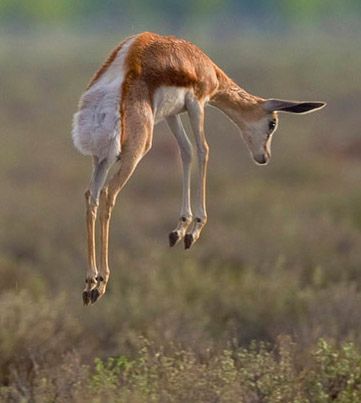Note: This is part one of a three-part series on the finer details of natural selection.
I realised recently that I didn't really understand how natural selection worked. I'd learned in school that natural selection was about the survival of the fittest. But the fittest what? It wasn't clear what the unit being selected was. A species? A group of organisms? Or individual organisms?
Sometime later I came across Richard Dawkins' The Selfish Gene, which tries to answer exactly this question. The unit of natural selection seems to have been a subject of fierce debate among biologists for decades. Some believed natural selection operated at the species level, i.e., the fittest species survive, and organisms work to maximise their species' chances for survival. Others believed the fittest groups survived. Yet others said that only the fittest individuals were selected for.
The fittest species/groups view was called group selection: organisms evolve in such a way as to maximise the fitness of their species or group. In the other camp, the favoured idea was individual selection: natural selection optimises for the fittest individuals.
Why does it matter what the unit of selection is? The unit of selection helps us understand what level of altruism we should expect to see in the natural world. If the group selection hypothesis is true, natural selection will select for species whose individuals are cooperative and willing to make sacrifices for the good of the group. Altruism within species would be the norm in the natural world, as species that are not altruistic will have an evolutionary disadvantage and be wiped out.
We do see some altruistic behaviour in animals – for example, members of certain bird species warn others using alarm calls if they spot a predator nearby, something that probably has some risk to the bird's life as it draws attention to itself. But Dawkins shows that the picture is more complicated than the group selection theory would suggest.
The Selfish Gene might be one of the best books I've read all year. The truth about natural selection is much more nuanced and interesting than I had thought. In this 3-part series of posts, I'd like to go into how natural selection actually works. I'll talk about the theories that biologists have advocated for – group selection, individual selection, gene selection. Then I'll talk about which ones ended up being true, and what implications this has.
But first, let's spend a brief moment on clarifying terminology.
Terminology: What do we mean by altruism?
Before we jump in: We're going to use the term 'altruism' a lot throughout this series. So let's take a moment to lay out Dawkins' definition of altruism, as it's more precise than the everyday use of the word:
Dawkins defines altruism as any action that reduces an organism's survival rate (however small the impact may be), in return increasing another organism's survival rate.
As an example, if a bird were to hunt for worms and feed them to its children, it is being altruistic – the mother spends her time and energy finding food, only to give them to her children instead of having it for herself. The mother also takes some risk in finding the food (of being caught by a predator), so she lowers her survival rate in return for increasing the survival rate of her children.
Terminology: What do we mean by a gene?
Typically by a gene, we refer to a continuous section of DNA that is responsible for a certain effect on the individual that has the DNA. But Dawkins uses the word gene more broadly: he means any section or combination of sections of DNA that produce some kind of effect on the organism. So while there might multiple sections of the genetic code that collectively control length of the bird's beak, for simplicity in these posts we will talk about a short-beak gene and a long-beak gene.
With that out of the way, let's start by talking about one popular view on the subject of natural selection for decades: group selection, and why it fell out of favour.
Group Selection
Imagine you're an antelope in the African Savanna. Most of your life is spent blissfully eating, sleeping, mating. Life is good. Except once in a while you get hunted by lions. During the trials of daily life, you have to make decisions about who to help and who not to. You could optimise for the success of your group: Maybe your herd, or maybe your entire species. Or you could be selfish and only help yourself.
At first glance, one might assume antelope, and many other species, optimise for the success of their group. One example of what looks like altruism is stotting. When antelope are being chased by predators, sometimes the stronger ones seem to bravely draw attention to themselves and away from members of their herd, by leaping high in the air as they run away from the predator.

Natural selection should also favour species whose members are good at working together. The antelope that takes one for the team and sacrifices its own life, thereby saving two others, would allow the herd to be more successful.
In other words, the unit of selection is the group. The fittest groups survive, and the forces of natural selection shape organisms so they most benefit the survival of their group. Groups here may mean an entire species or some group of animals, like a herd.
This was the group selection theory. It sounds intuitively pleasing and was the accepted orthodoxy for a long time. After all, doesn't it just make sense? Groups or species compete with each other, and if members of a species can cooperate with each other the species will be more likely to survive than species whose members are selfish. Therefore, shouldn't natural selection encourage the survival of collaborative and altruistic species?
The free-rider problem
But then we look a little closer. The antelope isn't stotting to distract the lion from the rest of the herd. Rather, the leaps are an honest signal to the lion: "I'm healthy, strong, and agile, don't waste your time trying to catch me. Try that other one who can't jump as high, he's probably weaker!"
Similarly, birds seem to be altruistic when they make alarm calls. But evidence suggests that alarm calls could be a signal to the predator rather than to fellow birds. The bird tells the predator that it has been noticed, so its not worth continuing the hunt in that area – the element of surprise has been lost.
The problem with group selection is that it's difficult to make unselfish cooperation for the good of the group the strategy that succeeds in the long run. Even if altruism helps the group succeed, an individual could benefit from being selfish when cooperation is not in the individual's interest.
Let's say we initially start with a group of organisms that act to maximise the fitness of their herd. The organisms in the group are altruistic; willing to risk their own lives for those of other members of their herd. Eventually, due to random mutations a "free rider" would evolve who would be selfish; willing to benefit from the altruism of others but unwilling to altruistic themselves. Their selfishness makes them more likely to survive and gives them more time and energy to pass their genes on to the next generation – the selfish organism has an evolutionary advantage. With each generation, the selfish individual's genes will proliferate until the entire population is selfish.
This is called the free-rider problem.
Stated more simply, altruism is not stable. Even though the species would be better off if all their members were altruistic, altruism to ensure the survival of the species is not a stable strategy.
Side note: This free-rider problem is analogous to the Prisoner's Dilemma problem taught in game theory. Even though both the prisoners staying silent would result in a better outcome for both of them, a rational actor would always choose to betray instead.
Conclusions
So that was group selection and the argument against it: organisms don't evolve to sacrifice themselves for the good of their species or group; natural selection acts against such in-discriminate altruism. Yet we do see some altruism in the natural world – parents taking care of their young is very common, but we also see animals that are not genetically related helping each other out even at some cost to themselves. How does this work if not by group selection?
In the next post, we'll look at individual and gene selection, and how altruism works if the group selection hypothesis isn't true.
Update: I've published part II. You can find it here.
